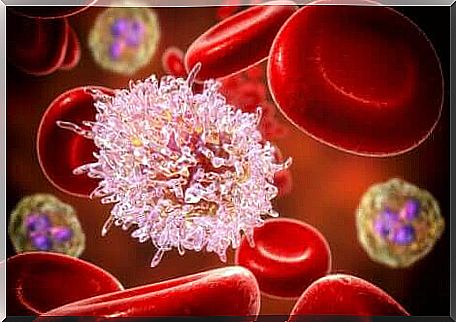Canine Leukemia: Causes And Symptoms

Canine leukemia is a type of cancer that fortunately is not that common in four-legged friends. Still, it is important that you take care of your dog’s general health. This way, you can quickly identify and treat the disease if it occurs.
Do you know what leukemia is ? Do you know the causes and characteristic symptoms? In the following we will give you answers to these and many other questions.
What is leukemia
Leukemia is a type of cancer that causes the number of white blood cells in the blood and bone marrow to increase. In dogs, there are two types: the lymphoid leukemia and myeloid leukemia.
Lymphoid leukemia is caused by cancer cells in the lymph nodes that damage tissues and increase the number of white blood cells. Myeloid leukemia, on the other hand, occurs when cancer cells form in the bone marrow.
In general, experts consider acute myeloid leukemia to be the more dangerous of the two. However, you shouldn’t rule out the danger just because one of the two types turns out to be chronic.
Keep in mind that the symptoms of leukemia in dogs can get worse. Without proper treatment, this disease can be fatal to your pet. Fortunately, however, there are clear signs that will enable you to act in a timely and correct manner.
If you experience symptoms of leukemia in your dog, you should contact your veterinarian immediately so that they can devise an appropriate treatment plan. Below we dig deeper into some of the causes, symptoms, and diagnostic methods for canine leukemia.

What Causes Canine Leukemia?
Unfortunately, the experts have not yet been able to pinpoint the causes of leukemia in dogs. However, for the most part, veterinarians agree that it develops spontaneously. Thus, the leukemia would be a cellular mutation in the bone marrow.
However, many veterinarians are of the opinion that there are some elements that predispose dogs to this disease, although they have not yet been able to pinpoint the exact causes. Examples of factors that can cause leukemia include exposure to radiation (including radio waves generated by household appliances).
In addition, some viral diseases and exposure to toxic chemicals (including some cleaning products) can also be predisposing factors.
Because scientists have not yet fully identified the causes of canine leukemia, it is not entirely preventable. However, a balanced diet and regular exercise can largely reduce the risk of developing the disease.
The symptoms of leukemia in dogs
Symptoms will vary slightly depending on the type of leukemia your pet has. In addition, they also depend on whether the disease is chronic or acute. In acute leukemia, symptoms worsen quickly and require immediate treatment.
In contrast, symptoms of chronic leukemia are a little more difficult to spot initially. As the pathology spreads over time, with a chronic course the signs develop very gradually.
Some dogs with chronic leukemia show no symptoms at all. In these cases, the only way to detect the disease can be through routine blood tests. For this reason, it is extremely important that you regularly bring your pet to your veterinarian for a routine check-up.
Leukemia usually affects adult or older pets, most often six years or older. Some of the most common symptoms to look out for include:
- Pale gums
- Whitish colored tongue
- Sudden loss of appetite or weight loss
- weakness
- fever
- Vomit
- Excessive thirst or sudden dehydration
- Irregular breathing or an irregular heartbeat
- Bruising or excessive bleeding from small wounds
- Constant infections
- Slow healing
- Changes in the dog’s temperament or aggressive behavior
Unfortunately, these symptoms are almost identical to those of many other diseases, such as many other types of cancer or autoimmune diseases. You should therefore consult your veterinarian for a correct diagnosis.

The diagnosis
In many cases, the disease develops slowly, and its external and obvious symptoms do not appear at the initial stage. Because of this, in most cases, leukemia is detected through a routine blood test.
If your dog’s blood test shows high white blood cell counts, your vet will likely do additional tests. These tests will determine whether the white blood cells suggest an infection, leukemia, or other illness.
If you still have your dog’s previous blood tests, you should provide these results to your veterinarian as well. In this way he can determine the “normal” values of the animal before the disease.
In the event your vet diagnoses your dog with leukemia, they will determine the best treatment option. In general, most symptoms can be relieved. Although leukemia can never be completely cured, many dogs still survive for years.









